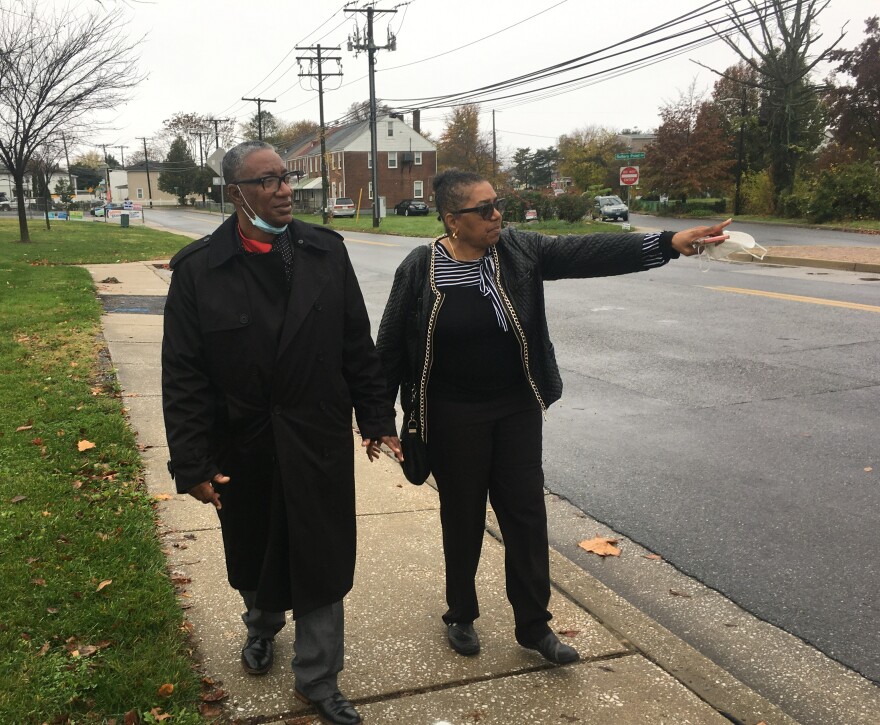Editor's Note: This is WYPR’s first story in ongoing coverage of the environment in Maryland known as Climate Change In Your Backyard.
As Olivia Lomax rode around the streets of Turner Station, a historically Black neighborhood which sits on a peninsula near Dundalk in Baltimore County, she remembered when floodwaters threatened her daughter’s home nearby.
Lomax offered a tour of the community nearby an old Bethlehem steel site that was once an economic hub. Some homes there have a view of Bear Creek that flows into the Patapsco River and eventually into the Chesapeake Bay.
Driving around the neighborhood sparked a flashback to when streets looked more like rivers. During one storm, she saw floodwaters encompass more land in lower lying areas.
“But if you look down you can see, it was like a river running through all of that,” Lomax said, gesturing towards a sloped road.
There are fewer than 3,000 residents left in the neighborhood. Roughly 66% of the population is Black, according to estimates from the Dundalk U.S. Census data when Turner Station boundaries are carved out. Residents there say streets and sometimes homes have flooded for decades.
But as climate change has contributed to sea level rise flooding has gotten worse because the water table is higher. It’s more expensive to get flood insurance for homes, residents have raised critical residential infrastructure to stay dry. The local, state and federal government understands how bad it is but nobody knows how much it would cost to fix.
Turner Station has always been prone to flooding, but Lomax said it’s gotten worse.

After the drive, Lomax and other neighbors gathered at the home of 97-year-old Zenobia Batchelor.
They call Ms. Batchelor the matriarch of Turner Station. She’s lived there for 70 years.
“When the downpours come it just saturates everything, just go from front to back,” Batchelor said.
Elma Jones said the flooding happens more frequently and the waters are rising higher.
“The flood comes up to the porch, almost to the top of the porch,” Jones said. “And my basement floods out. My son lives up the street. He’s lost two sets of washers and dryers with these last two floods.”

Residents like Renwick Glenn believe Turner Station has been ignored.
“Because it’s a Black community and our elected officials do not come here and do what they’re supposed to do,” Glenn said. “The money that was allocated here, they put it somewhere else.”
Glenn believes nearby white neighborhoods are getting their flooding issues addressed while Turner Station is ignored. So does Michael Hancock, who is 59 and was born and raised here.
“I would like not to think that it’s a racial issue but it is what it is,” Hancock said.
On this day, it’s raining but not enough to cause flooding. There are puddles here and there. Strolling along Sollers Point Road,
Hancock and Lomax point to a storm drain filled with water.
“Any day, any given day, it’s filled like this,” Lomax said. “Not just because it’s raining.”
Hancock said when it floods, “You can’t see the sidewalk. You can’t see any of this.”
Lomax added, “And the day after you know what you see? You see a lot of trash.”

Those pipes are filled with water, even on dry days, because of rising sea levels caused by climate change according to Jenn Aiosa, Baltimore County’s Chief Sustainability Officer. Water in Bear Creek makes its way into the pipes. Also, Aiosa said the pipes running under the neighborhood were designed to handle the load from storms we had 50 years ago.
“Not for the kinds of storms that we’re seeing more and more of,” Aiosa said. “So we’re seeing older communities, lower lying communities, and often these are poorer communities dealing with intermittent flooding.”
Climate scientists are predicting more intense downpours that can overwhelm aging drainage systems.
Aiosa said they are working with the community to find solutions, and that includes a study by the Army Corps of Engineers.
“Who has done some modeling, not only of flooding now, but what we might expect to see in the future because of climate change,” Aiosa said. “And then we are beginning to look at what combination of solutions might be helpful here.”
The study by the Corps found that a one-two combination could significantly diminish the flooding risk in Turner Station. First, you need a flap on the pipe that dumps stormwater into Bear Creek. It would allow water to leave the pipe, but would keep any of the creek from coming in. You also need a pumping station that would push the water down the pipe. The exiting water would open that flap and then flow into the creek.
Jason Stick, the project manager for the U.S. Army Corps of Engineers, Baltimore District, said part of the problem with the storm drain system is that there is no slope in the pipes.
“They’re almost completely flat,” Stick said. “So in order to get the water ahead and push it out of the pipe you need a pump station.”
But no one is putting a dollar figure on what that would cost.
There is federal money available through the infrastructure legislation passed by Congress last year. Baltimore County now has to apply for grants. Localities from across the country will be vying for government money available. The sources of funding include the Federal Emergency Management Agency, the Environmental Protection Agency, and the National Oceanic and Atmospheric Administration.
Congressional district lines were redrawn this year. Come January, Turner Station will have one of its own representing the neighborhood in Congress. Rep. Kweisi Mfume, a Democrat, lived there as a child.
“The ball is now in my court,” Mfume said. “I want to run with it. It’s very important to me. And it’s important to the people who live there and call that home.”
According to Mfume’s office, available money this year includes $2.3 billion from FEMA for reducing the risk from disasters and $42.6 million from the EPA for upgrading old sewer systems.
Until redistricting earlier this year redrew his district, Rep. C. A. “Dutch” Ruppersbeger, a Democrat, had represented Turner Station in Congress for 20 years. Ruppersberger is requesting $2 million in federal funding for an extensive study of the threat of future flooding in Turner Station.
Ruppersberger said combating the effects of climate change needs to be a national priority.
“Because it’s going to cost us billions if not trillions of dollars down the road if we just close our eyes to that major issue,” Ruppersberger said.
County Executive Johnny Olszewski said there is no doubt Turner Station has been historically overlooked, but he added that’s changing, pointing to things like that Army Corps of Engineers study and ongoing sewer work
“We are fully committed to doing all that we can to address those historical inequities that have existed far too long here and unfortunately in other communities across the county,” Olszewski said.
Some residents in Turner Station have taken matters into their own hands. Air conditioners are put on raised platforms to protect them from flooding. Basement windows are sealed.
The cost of dealing with climate change can range from big ticket items like a new pump station, to the cost of replacing appliances ruined by flooding. Or in resident Shawnie Quarles’ case, paying more for flood insurance.
“The regular insurance was going to be like, I want to say like $1000 a year but it bumped it to like $2000,” Quarles said. “It like doubled the insurance.”
Some streets in Turner Station are in Federal Emergency Management Agency flood map zones where mortgage lenders require flood insurance due to higher risk of flooding, especially those closer to the creek, but not all. That means some homeowners may not even purchase flood insurance because it’s not required.
For an average home along Chestnut Street, there is a major risk of coastal flooding, according to nonprofit FloodFactor. In the next three decades, that property has a 98% chance of flooding at least once, data shows.
Quarles and others in Turner Station do not doubt that climate change is making matters worse. They believe their community is in jeopardy.
“You think about it, all them glaciers, they are melting,” Quarles said. “The sea level is rising. The atmosphere is changing. The pollution of course is aiding to it. Everything we do affects our way of life.”







